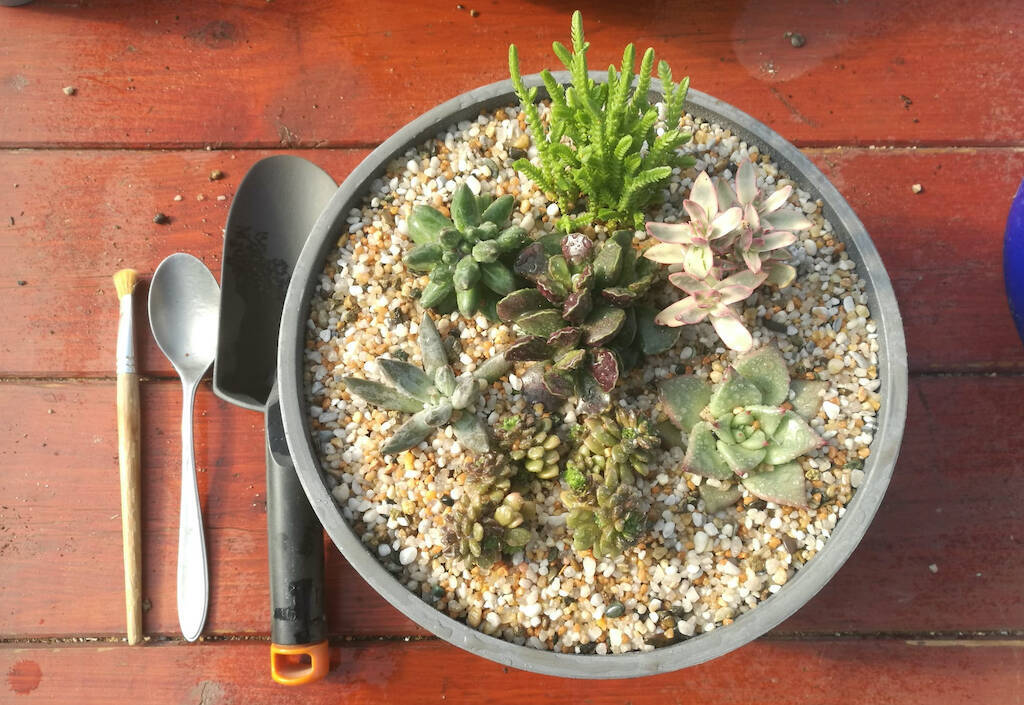Better to set the record straight right away: the topic of compositions has very little to do with the spirit of this site. In fact, we are just the opposite: on the one hand, the spartan approach that aims to obtain plants similar to those in habitat and that is the basis of my cultivation method; on the other hand, cultivation for aesthetic purposes only, which I do not practice but which we know very well is widespread. But life, as you know, is never all black or all white; some nuance must always be there…. So, here is an article accompanied by a video of mine on how to make a simple succulent plant arrangement. After all, an eye for aesthetics never hurts, and even I, who love “lived-in,” nature-like plants, do not disdain a well-done composition, as long as it is no-frills and made with respect for the needs of the individual plants. Warning: the theme may seem obvious and the subject matter very simple, but it’s not so and you will understand why in the next lines. Assuming that in plant compositions everyone is free to do what they want, this is just an aesthetic field, that is, related to personal taste, if you want to make compositions that will last over time and that will not make the plants suffer or die quickly, it will be wise to choose the right essences judiciously and place them in the correct substrate.
Let’s see in this article how to correctly choose the plants for our compositions (…)
Avoiding difficult cohabitation
First of all, compositions with different plant families should be avoided: succulents together with tropical plants such as orchids, or succulents together with carnivorous plants, just to mention a couple of examples, are combinations to be discarded without any doubt. The needs of plants belonging to different families can be completely irreconcilable, and by making an arrangement we are forcing some plants into a coexistence (in a pot, bowl or any container) that in nature would never occur and that in the long run is bound to fail. So why should we throw away time, labor, materials and plants just to enjoy for a few days or a few weeks a combination that only works from the point of view of our aesthetic standards?
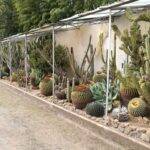
Being coherent with the philosophy of this site, let’s then talk about arrangements made only with succulent plants (vulgarly known as “fat plants”). Again, however, it’s important to consider that the world of succulents is very broad and includes dozens of families, hundreds of genera and thousands of species, each with its own specific needs. In some cases the needs are compatible, in others less so, and in others not at all. A first important distinction to do is between cactaceae and noncactaceous succulents. As is usually said, while it’s true that all cacti are succulent plants, it’s true at the same time that not all succulent plants are cacti. And the difference between a cactus and any other succulent (e.g., a Lithops, a Crassula, an Euphorbia, etc.) can be quite remarkable not so much in shape and appearance as in growing requirements. So much so that the coexistence of these plants in a single pot may prove impossible or at any rate short-lived.
For those who want to approach the subject and begin to understand the difference between a cactacea and any other succulent plant, I recommend reading this introductory article of mine on classification. Don’t be frightened by the topic: actually learning to distinguish the various succulent plant families is less difficult than it may seem!
Choosing plants
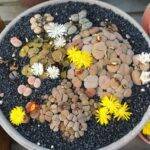
The first criterion in identifying plants for composition is based, of course, on the personal taste. Anyway, it may be useful to keep in mind a few simple pointers. For example, it may be interesting, for the purposes of the final result, to choose plants with different bearing, so as to achieve a “wavy” composition, with tree-like succulents and others with low or prostrate habit. But even this, all things considered, is related to the aesthetic taste, and compositions made with several specimens of a single succulent genus can also prove pleasing. One example? The classic bowls filled with Lithops, the so-called “stone plants”: they are beautiful because of their similar shape but infinite color shades. On the other hand, the “objective” factors to regard when placing several plants in one container are the following: soil, frequency of watering, minimum tolerated temperatures, and exposure. Assuming that we are talking here about succulent plants, the combinations can be many, as long as we choose plants that have similar needs in terms of soil, watering, temperature and exposure. It is enough to know a minimum of the characteristics of the various succulent families to select which plants we can combine and which are better not to keep in one container. An example: I do not recommend putting cacti with leafy succulents (e.g., Crassula, Echeveria, Hoya, etc.) in the same composition. The reason is very simple: cacti can live for months without water, while most leafy succulents if they stay dry for a few weeks start to perish. The water requirements of these families are very different, and while coexistence is still possible, my opinion is that it’s not the case to complicate life and, above all, make the plants suffer or otherwise grow in unsuitable conditions.
Related to the frequency of watering is the issue regarding the potting soil: a cactacea, as well as a Lithops or several species of Euphorbia with a compact bearing, grows best in poor substrates, with a lot of aggregates and little organic material, while leafy succulents need significantly higher percentages of organic matter (at least 50 percent). It’s clear that in a container shared by all plants, we are not able to use different potting soils according to individual needs, but we have to to stick to the criterion of “one size fits all,” that is, the product that will satisfy all needs.
Temperatures are also important, unless we decide to keep the composition indoors all year round (but I’ll never recommend it for succulent plants). There are succulents, such as cacti, that in dry potting soil can tolerate temperatures well below freezing without problems; others that cannot go below 12-14 degrees (e.g., Adenium, several species of Euphorbia, and all succulents native to Madagascar).
Similar discussion for exposure: some succulents want a lot of light, if not direct sun, while others do not tolerate excessive levels of sunlight and grow well in half shade (many Euphorbia and the Haworthia, to name a couple of cases). Clearly, if we put several plants in one container, it’s appropriate to choose specimens with similar light requirements, so that we do not have problems or imbalances in growth, with healthy plants and others sunburned or etiolated and suffering from too much or too little sun.
Choosing the container
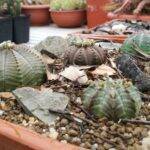
This is a purely aesthetic question related to personal taste, as much for colour as for shape (square pot or rectangular box, round pot, tall pot, low pot, bowl, etc.). Just a couple of considerations: the container chosen for compositions must be adequate for the number of plants we intend to place and must be deep enough. In other words, the container must be able to comfortably accommodate the root bread of the plants that you place there. This may seem like an obvious clarification, but taking into account that very often for compositions we use those beautiful enameled pots for bonsai, I think it’s necessary to remember that the less space we give the roots to be able to develop, the more we limit the growth of the plants (and maybe this is exactly what we want: to make a composition in which the plants are always “under control,” that is, of limited size…). When choosing a container, the only imperative is: make sure it has drainage hole(s)! Water stagnation is detrimental to all types of plants, except aquatic plants…. Regarding the material, anything can be ok, and each element, terracotta, plastic, aluminum, wood, can be valid or not.
For a more in-depth look at the topic, I recommend reading this specific article.
How to proceed
Once the plants and container have been chosen, the first thing to do is to try arranging the succulents in the new pot or bowl without removing them from the plastic pots to get an idea of how to make the composition. For this purpose, it may be useful to spread a layer of one or two centimeters of expanded clay on the bottom of the new pot: this way we can easily move the plants around and try several combinations to get arrangement we like best. Of course, we can also decide to include other elements in the composition, such as rocks or pebbles of various sizes. Again, the “trial run” with the plants still in their individual pots is most useful to get clear ideas before proceeding definitively.
Once we have found the arrangement we prefer, it can be useful to take a photo with the cell phone (which is always handy), so that any doubts can be cleared up immediately when we go to repot the plants by removing them from their individual pots to arrange them in the new container. If the plants are in the correct substrate, i.e., peat and aggregates, it’s enough to take them out of the pot, check that there are no pests in the root ball, and place them in the new container, at the bottom of which we have placed some potting soil. If, on the other hand, the plants we need to repot are in pure peat (as is often the case when buying them from non-specialized nurseries), it’s a good idea to remove some of the potting soil and untangle the roots as much as possible. With cacti this procedure should be done very firmly, removing all the peat with the help of a brush and, in case the soil loaf is very dry, with a stream of water (before repotting, however, it’s necessary to leave the plant with the roots in the air for at least a week).
Once the plants have been placed in the new container, all we have to do is fill it with potting soil, starting from the edges and going all the way to the center, avoiding leaving gaps here and there. This is both to give stability to the plants and to avoid stagnation or “puddles” when we water. When we have filled the pot with the substrate and stabilized the plants, it will be useful to tap the container lightly and several times on the shelf so that the potting soil is evenly distributed. Remember to stand at least an inch and a half below the rim of the pot with the substrate so that there is no spillage of potting soil when we water.
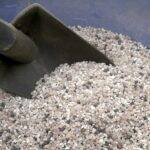
Finally, to complete the composition, if you like the effect, it may be useful to spread a layer of grit on the surface. You can use river gravel or aquarium quartzite (you can find it in every color): this is also a matter of personal taste. Beyond the aesthetic aspect, however, spreading a relatively heavy layer of inert material on the surface is a great way to even out the color of the substrate and to keep the pot tidy, especially when watering. The layer of inert material (it is best to avoid porous materials such as pumice and lightweight materials such as perlite) should be one centimeter thick at most. If we use gravel or quartzite, the water from watering flows quickly between the pebbles and doesn’t form stagnation around the collar. At the same time, the grit layer ensures that in the warmer months the water doesn’t evaporate too quickly, particularly if we have used a very draining potting soil. Another material to avoid for the surface layer of the arrangements is fine sand: it retains moisture around the collar of the plants for a long time, and with “vigorous” watering it leaks everywhere.
Landscaping
Quite different from the concept of “composition” is that of “landscaping“. In this second case, compositions are made with plants, but the ultimate goal is to reproduce as closely as possible the aesthetic appearance of the natural habitat. Take a look at this video and you’ll understand immediately what I mean! Thus, for these compositions there are very precise rules that govern the choice of plants, potting soil, elements that embellish the composition (rocks, branches, shrubs). In short, here the aesthetic criterion is oriented by reality, so much so that in order to create these small “habitat cutaways” one is inspired by Nature, observing in detail photographs of the environment one intends to reproduce and using materials that are compatible if not identical to those found where succulent plants grow wild (marl, chalk, field soil, sand, etc.).
SUBSCRIBE TO THE SITE – If you liked this article, subscribe to the site to have access to all the contents for one year or three months depending on the formula you choose. Here you will find terms and conditions.
SUBSCRIBE TO THE NEWSLETTER – If you want to receive the free newsletter every time new content is published (even if you have not subscribed to the site), fill in the fields at this link!
My video
Correlated articles
Six identical cacti in three different soils
How to repot cacti and succulent plants
Substrates for cacti and succulents
Fertilization: how and when
© The texts, videos, photos and graphic elaborations of the site “Il fiore tra le spine” are original material and are covered by copyright. It’s forbidden to reproduce them in any way.


